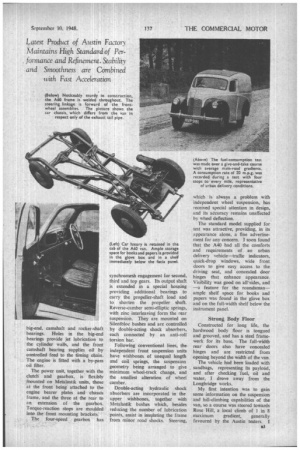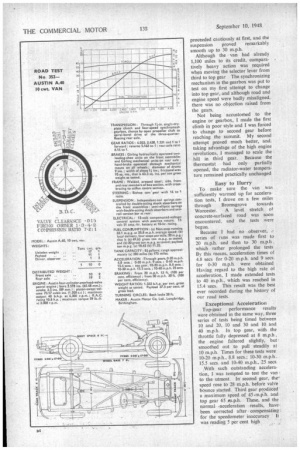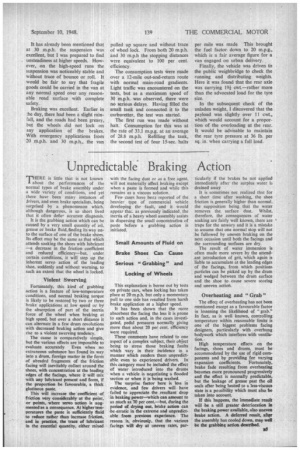Austin 10-cwt, Van Offers Car Performance
Page 36

Page 37

Page 38

Page 39

If you've noticed an error in this article please click here to report it so we can fix it.
Says L. J. COTTON, M.I.R.T.E. BRISK performance and exceptionally smooth suspension were outstanding features noted during the test of the Austin A40 10-cwt. van. Except for a slight modification to the exhaust tail pipe. the chassis is essentially similar to that of the A40 car. including the refinements of the facia panel and cellulose-acetate-covered steering wheel.
Compared with its predecessor, the A40 engine develops 17 per cent. greater power per litre. This additional power has been gained in the change-over to overhead-valve design and by increasing the compression ratio to 7.2 to 1. The cylinders are cast integrally with the crankcase, in the usual way, with full-length water jackets. A detachable cast-iron head carries the valve gear.
Reducing Valve Noise To promote quiet running, the adjustable ball end of the rocker gear is drilled to convey oil under pressure to the space between the ball and the cup of the push-rod. The push-rod is a close fit round the ball end, thus providing a cushioning effect between the two. Whilst the pressure is insufficient to open the valves, it is enough to maintain a state of 'no-clearance when the engine is running, thus effectively dampening out valve noise.
Three hearings support the crankshaft, and both these and the big-end bearings are of the Thinwall pattern
s2
Driven from the crankshaft by a duplex roller chain, the camshaft sprocket incorporates an automatic tensioner in the form of a synthetic rubber ring located in the groove between the two rows of teeth.
This serves the dual purpose of eliminating noise and compensating for chain slackness, the rubber ring being of sufficient dimension to enable the chain to seat on the rubber.
Split-skirt anodized aluminiumalloy pistons with a compression,
taper and an oil-control ring are fitted, the connectingrods being steel forgings. The combustion spaces in the cylinder head are kidney-shaped, with the valve heads located in the flat sections of the kidney:
This ' arrangement enables an adequate water supply to circulate in the region of the valve seats and promotes turbulence in the incoming mixture. The exhaust valves are made from a heatand corrosion-resisting steel, whilst the inlet valves are of silicon-chrome alloy steel. Oil seals are fitted to all valves.
A gear-type oil pump circulates lubricant under pressure to the main, big-end, camshaft and rocker-shaft bearings. Holes in the big-end bearings provide jet lubrication to the cylinder walls, and the front camshaft bearing supplies oil by controlled feed to the timing chain. The engine is fitted with a by-pass oil filter.
The power unit, together. with the clutch and gearbox, is flexibly mounted on Metalastik units, those at the front being attached to the engine bearer plates and chassis frame, and the three at the rear to an extension of the gearbox. Torque-reaction stops are moulded into the front mounting brackets.
The four-speed gearbox has synchromesh engagement for second, third and top gears. Its output shaft is extended in a special housing providing additional bearings to carry the propeller-shaft load and to shorten the propeller shaft. Reverse-camber semi-elliptic springs, with zinc interleaving form the rear suspension. They are mounted on Silentbloc bushes and are controlled by double-acting shock absorbers, each connected by an anti-roll torsion bar.
Following conventional lines, the independent front suspension units have wishbones of unequal length and coil springs, the suspension geometry being arranged to give minimum wheel-track change, and the smallest alteration of wheel camber.
Double-acting hydraulic shock absorbers are incorporated in the upper wishbones, together with Metalastik bushes which, besides reducing the number of lubrication points, assist in insulating the frame from minor road shocks. Steering, which is always a problem with independent wheel suspension, has received special attention in design, and its accuracy remains unaffected by wheel deflection.
The standard model supplied for test was attractive, providing, in its appearance alone, a fine advertisement for any concern. I soon found that the A40 had all the comforts and requirements of an urban delivery vehicle—traffic indicators, quick-drop windows, wide front doors to give easy access to the driving scat, and concealed door hinges that enhance appearance Visibility was good on all sides, and —a feature for the roundsmanample shelf space for books and papers was found in the glove box and on the full-width shelf below the instrument panel.
Strong Body Floor Constructed for long life, the hardwood body floor is tongued and grooved, and has a steel framework for its base. The full-width rear doors also have concealed hinges and are restricted from opening beyond the width of the van.
The vehicle had been loaded with sandbags, representing its payload, and after checking fuel, oil and water, I drove away from the Longbridge works.
My first intention was to gain some information on the suspension and hill-climbing capabilities of the van, so a course was steered towards Rose Hill, a local climb of 1 in 8
maximum gradient, generally favoured by the Austin testers. I
proceeded cautiously at first, and the suspension proved remarkably smooth up to 30 m.p.h.
Although the van had already 1,100 miles to its credit, comparatively heavy action was required when moving the selector lever from third to top gear The synchronizing mechanism in the gearbox was put to test on my first attempt to change into top gear, and although road and engine speed were badly misaligned,. there was no objection raised from the gears.
Not being accustomed to the engine or gearbox, I made the first climb in poor style and I was forced to change to second gear before reaching the summit. My second attempt proved much better, and. taking advantage of the high engine revolutions, I managed to scale the hill in third gear. Because the thermostat had only partially opened, the radiator-water temperature remained practically unchanged
Easy to Hurry To make sure the van was sufficiently warmed up for acceleration tests, I drove on a few miles through Bromsgrove towards Worcester. A level stretch of concrete-surfaced road was soon encountered, and the tests were begun.
Because I had no observer, series of runs was made first to 20 m.p.h. and then to 30 m.p.h which rather prolonged the tests By this means, acceleration times ol 4.8 secs for 0-20 m.p.h. and 9 secs. for 0-30 m.p.h. were obtained Having regard to the high rate of acceleration, I made extended tests to 40 m.p.h., which was reached in 15.4 secs. This result was the best ever recorded during the history of our road tests.
Exceptional Acceleration
Top-gear performance results' were obtained in the same way, three series of tests being timed between 10 and 20, 10 and 30 and 10 and 40 m.p.h. In top gear, with the throttle fully depressed at 8 mph, the engine faltered slightly, but smoothed out to pull steadily at 10 m.p.h. Times for these tests were 10-20 m.p.h., 8.8 secs.; 10-30 m.p.h.. 15.5 secs. and 10-40 m.p.h., 25 secs With such outstanding acceleration, I. was tempted to test the van , to the utmost. In second gear, the' speed rose to 28 m.p.h. before valVe bounce started. Third gear prodked a .maximum speed of 45 .m.p.h. and top gear 65 These, and the normal -acceleration results, havebeen corrected after compensating for the speedometer inaccuracy It was reading 5 per cent. high
It has already been mentioned that at 30 m.p.h. the suspension was excellent, but I was prepared to find unsteadiness at higher speeds. However, on the high-speed runs the suspension was noticeably stable and without trace of bounce or roll. It would be fair to say that fragile goods could be carried in the van at any normal speed over any reasonable road surface with complete safety.
Braking was excellent. Earlier in :he day, there had been a slight rainfall, and the roads had been greasy, but the wheels did not lock on any application of the brakes. With emergency applications from 20 m.p.h. and 30 m.p.h., the van pulled up square and without trace of wheel lock. From both 20 m.p.h. and 30 m.p.h the stopping distances were equivalent to 100 per cent. efficiency.
The consumption tests were made over a I2-mile out-and-return route with normal main-road gradients. Light traffic was encountered on the tests, but as a maximum speed of 30 m.p.h. was observed, there were no serious delays. Having filled the small tank and connected it to the carburetter, the test was started.
The first run was made without halt. Consumption for this was at the rate of 33.1 m.p.g. at an average of 28.8 m.p.h. Refilling the tank, the second test Of four 15-sec. halts
per mile was made This brought the fuel factor down to 20 m.p.g., which is a fair average figure for a van engaged on urban delivery.
Finally, the vehicle was driven to the public weighbridge to check the running and distributing weights. Here it was found that the rear axle was carrying 191 cwt.—rather more than the advocated load for the tyre size.
In the subsequent check of the unladen weight, I discovered that the payload was slightly over 11 cwt., which would account for a proportion of the overloading at the rear. It would be advisable to maintain the rear tyre pressure at 36 lb. per sq. in. when carrying a full load.




















































































